Matador Network's Blog, page 2139
February 23, 2015
The 20 funniest French expressions

Photo: Ben Raynal
1. The French don’t “piss you off”…they “shit you off” (Faire chier quelqu’un).
2. The French don’t call you “idiotic”…they call you “as dumb as a broom” (Être con comme un balai).
3. The French don’t “blow you off”…they “give you the rake” (Se prendre un râteau).
4. The French don’t tell you that “they don’t care”…they tell you that “they care about it like they care about their very first shirt” (S’en foutre comme de sa première chemise).
5. The French don’t say “this is annoying me”…they say “I’m getting swollen by this” (Ça me gonfle).
6. The French don’t tell you to “leave them alone”…they tell you to “go and cook yourself an egg” (Aller se faire cuire un œuf).
7. The French don’t tell you that “you’re grumpy”…they tell you that “you’re farting sideways” (Avoir un pet de travers).
8. The French don’t “go crazy”…they “break a fuse” (Péter un plomb).
9. The French are not “bumbling”…they have “their two feet in the same clog” (Avoir les deux pieds dans le même sabot).
10. The French are not “energized”…they have “the potato” or the “French fry” (Avoir la patate/la frite).
11. The French don’t tell you “to mind your own business”…they tell you “to deal with your own onions” (Occupe-toi de tes oignions).
12. The French are not “broke”…they are “scythed like wheat fields” (Être fauché comme les blés).
13. The French are not “very lucky”…they have “as much luck as a cuckold” (Avoir une veine de cocu).
14. The French don’t say “it’s useless”…they say “it’s like pissing in a violin” (Pisser dans un violon).
15. The French are not “ungrateful”…they “spit in the soup” (Cracher dans la soupe).
16. The French don’t “fuss about something”…they “make a whole cheese about it” (En faire tout un fromage).
17. The French don’t “give someone a tongue-lashing”…they “yell at them like they’re rotten fish” (Engueuler quelqu’un comme du poisson pourri).
18. French men don’t “sleep around”…they “dip their biscuit” (Tremper son biscuit).
19. The French are not “big-headed”…they “fart higher than their ass is located” (Péter plus haut que son cul).
20. The French don’t “shup someone up”…they “nail someone’s beak” (Clouer le bec de quelqu’un). 
9 cities with actual cat cafes
If you thought cat cafes were a purely Japanese phenomenon, we’ve got good news (or bad news if you’re allergic): you can also drink coffee and snuggle kitties in cities all over Europe and Asia. And briefly this month, you could also do it in New York, at America’s first pop-up cat cafe.
If you couldn’t make it to New York, or if you can’t handle the long lines, never fear; permanent cat cafes are coming to San Francisco and Oakland, Portland, and LA. But until then, you can work kitty cuddles into your travel plans even if you’re not going anywhere near Tokyo. Here are nine other cities around the world where you can get cat love with your cappuccino.
1. Budapest, Hungary
Cat Cafe Budapest also bills itself as a gallery for cat-themed art.
2. Paris, France

Photo: Le Cafe des Chats/Facebook
Parisian cat cafe Le Cafe des Chats recommends that you make a reservation before visiting — the French are serious about their coffee and their cats.
3. Penang, Malaysia

Photo: Purrfect Cat Cafe Facebook
Purrfect Cat Cafe is located on an island off the coast of Malaysia. It seems like a bit of a headache to get there, but how can you deny these faces?
4. Vienna, Austria
Vienna is famous for its coffeeshops. Some used to be gathering places for famous writers or composers, but only Cafe Neko is full of cats.
5. Bangkok, Thailand
Purr Cat Cafe Club features cat-shaped scones and some of the most outrageously cute kitties we’ve ever seen.
6. Devon, England
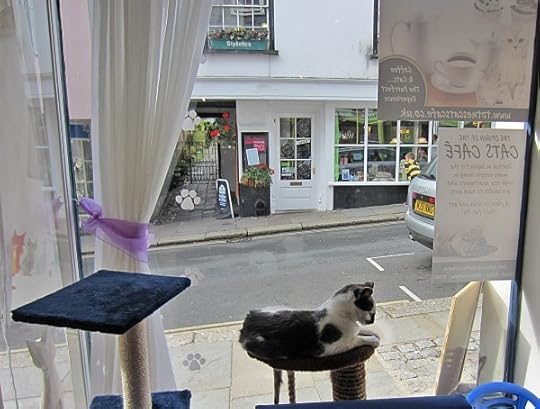
Photo:
Totnes Cats Cafe Facebook
Totnes Cats Cafe
7. Madrid, Spain
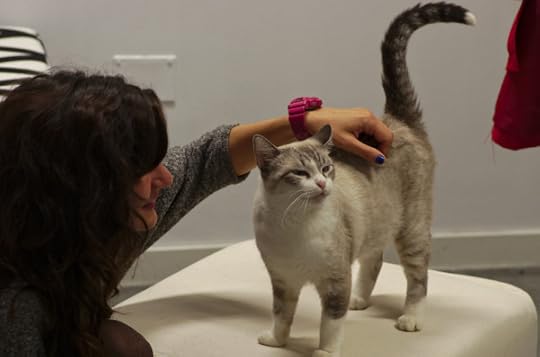
Photo La Gatoteca Facebook
For some reason all the cats at La Gatoteca look a little pissed off, but they’re probably just being European. Or maybe they just hate that mural.
8. Berlin, Germany

Photo: Pee Pees Katzencafe Facebook
The name is a little on the nose, but this German Pee Pees Katzencafe is a haven of both cute cats and fancy baked goods.
9. Seoul, South Korea
Seoul actually has a number of cat cafes (and a bird cafe! Drink your coffee with flying dinosaurs!). Here are some pictures from one of them, Cats Living. 
By Jess Zimmerman, GlobalPost
This article is syndicated from GlobalPost.
February 22, 2015
You know you live in Oz when...

Photo: Harald
1. Most of your income goes towards beer.
The rumors are true. Australians love their beer. Unfortunately, it’s also true that shit is way more expensive on their massive island. Remember the good old days (before you lived in Australia) when you could get a 30-pack of PBR from the local liquor mart for under $20? Those days are long gone. Add a beer category to your monthly budget because $50 for a carton is bound to take its toll on your bottom line.
2. You miss the sound of geckos when you travel.
To answer your first question, yes, geckos make sounds. You immediately learn this fact when trying to fall asleep in your newly-renovated Queenslander. Chirp chirp chirp. At first, you are disgusted that tiny lizards wander in and out of your house as they please, but after a while, they sound like home.
3. A “flat white” is now your go-to coffee order.
Thought coffee orders were universal? Think again. Flat white and long black are actual drink orders down under. After a few months, you’ll understand that an Australian cappuccino is not half foam like the Starbucks brand you know and love, but it does come sprinkled with delicious chocolate powder, so that’s a bonus.
4. You learn the true meaning of BAMF: Ned Kelly and Chopper.
Forget about James Bond and Die Hard. Australia’s got their own breed of real life bad asses, and they are damn proud of them. Once you unpack your suitcases in Australia (originally founded as a penal colony), there is no way around adopting Ned Kelly as your new Robin Hood and viewing Chopper as the legend that he was.
5. Elite status never came so easily on your chosen airline.
Once you move to Australia, you truly understand just how big of a country it really is. Traveling also helps to show you just how far away it is from every other country in the world. While this doesn’t do wonders for your wallet (especially if you don’t live in a major Australian city), it does accelerate your climb up the mileage ladder. You’ll be getting free upgrades to first class in no time!
6. Wearing a floppy sun hat is for everyone, not just movie stars.
With skin cancer being a box commonly checked on most Australians’ medical records, sun protection is very important. Instead of laying on the beach basking in the UV rays like you originally intended when you moved to the land of sunshine, you now have an array of floppy-brimmed hats that are completely acceptable to wear at any outdoor occasion.
7. Everything takes 6x longer to download anything.
You’d think that a developed first world country like Australia would have hopped on the broadband wagon long ago, but sadly this is far from the truth. According to a recent report from cloud service provider Akamai, Australia ranks 44th globally for internet speed. And after your Dropbox files take nine hours to sync, you’ll know they aren’t lying…
8. You suddenly don’t understand a single thing about politics.
Sooo… there’s a prime minister and some people called premiers that all hang out in Parliament and force you to vote. Somehow the Queen is still involved, yet you met last week with your town’s mayor for coffee. For anyone who moved to Australia from a democracy, you’re in for a treat. Time to get your British History notes back out from high school and piece together this political puzzle. Or, just join the Aussie masses who also have no clue what’s going on in Tony Abbott’s world.
9. “Mate” becomes the most used word in your vocabulary.
Whereas before you only used the word when cheekily putting on your best Aussie accent, now you don’t even realize that it creeps in every other sentence. “Dude” and “man” have entirely left your vernacular (thankfully), and accompanying a friendly wave with a “G’day mate” has never felt more natural.
10. Friends finally want to come visit you…but never do.
“I’ve always wanted to visit Australia!” But do they actually ever spend half their monthly income to buy the plane ticket? Nope. When you move to Australia, you get used to it. Of course people want to come visit the beautiful Gold Coast beaches and schedule a photoshoot snuggling a joey, but the reality is, you live thousands of miles from all your non-Aussie friends. Get used to FaceTime.
11. Your wardrobe no longer includes wool.
All those sweaters and pea coats seemed to have magically disappeared from your closet over the years. You now own more bikinis than pairs of socks, and your long underwear sits packed away with your snowboard gear. Although, on those Victoria winter nights, you sometimes wish you’d kept your Peruvian alpaca sweater handy.
12. Good Mexican food ceases to exist.
Sure there might be the occasional Guzman y Gomez on the corner, but they don’t even hold a candle to Qdoba, let alone those delicious hole-in-the-wall finds awaiting you back in America. Fill up on your burrito quota while racking up those frequent flier miles, because Australia definitely doesn’t live across the border from Mexico.
13. You finally start understanding cricket.
Ha! Just kidding! No one understands cricket. 
21 reasons you should move to Seoul

Photo: IAN/Flickr Commons
You can also gaze upon the coolest, most sprawling neon-lit cityscape you’ll ever see.
2. There’s such a thing as haute-couture hiking.

Photo: CHELSEA MARIE HICKS/Flickr Commons
You can’t go a month without at least one hike. And some Seoul-lites take their hiking gear very seriously.
3. The spicy food will test your stomach of steel (yes, that’s a good thing).

Photo: RYAN PICKKEL/Flickr Commons
Restaurateurs will question your ability to indulge in fiery pepper-laden pickled dishes. Prove them wrong.
4. The internet is so good you can watch television on your smartphone in the subway.

Photo: BRENT SCHMIDT/Flickr Commons
Searing data speeds in Korea, the fastest in the world, mean your phone doubles as a portable television.
5. The booze is cheap, abundant, and a prerequisite for everything.

Photo: JAMIE CARTER/Flickr Commons
Your boss will probably order you to drink liters and liters of soju, a $1.25 bottle of liquor that tastes like vodka. It’s occasionally mixed with beer to concoct a hangover-inducing cocktail called somaek.
6. Did we mention it’s really abundant?

Photo: MARK ZASTROW/Flickr Commons
Jinro soju, the country’s most popular brand, is consumed more than any other liquor label in the world. Vodka comes second.
7. The mountains are endless, and endlessly beautiful.

Photo: MINYOUNG CHOI/Flickr Commons)
They’ve captivated Koreans for centuries as the source of folklore and spiritual beliefs. In myth, the Korean people originated on one, as did the former North Korean dictator, Kim Jong Il.
8. The karaoke bars are better than your bars.

Photo: RINUX/Flickr Commons
In Korea, it’s called noraebang. Psy and Rain are splashed all over the repertoire.
9. Gangnam style is more than just a dance.

Photo: STEVE KOON/Flickr Commons
Nose jobs and Louis Vuitton handbags are everywhere in this Beverly Hills-style district. More importantly, it’s a place to pay homage to the world’s most famous horse-galloping rapper.
10. Pirates of the Caribbean has its own knock-off.

Photo: SEUNG PARK/Flickr Commons
“Pharaoh’s Fury,” a ride at the Lotte World theme park in Seoul, offers the delights of Disneyland on the other side of the Pacific.
11. This mystery “sculpture” greets you at the Incheon airport.

Photo: PANDU POLUAN/Flickr Commons
Is it a giant, erect penis? Nobody knows.
12. Shamans and séances call all the big shots.

Photo: BRIAN MILLER/Flickr Commons
Ancient spirit work thrives in this high-tech city. Politicians and CEOs regularly consult their shamans, called mudangs, before making tough decisions.
13. The Korean rock scene is awesome.

Photo: RECANDPLAY.NET/Flickr Commons
Forget K-pop. The university district of Hongdae is home to one of Asia’s coolest indie scenes.
14. But the real rock stars are professional video gamers (it’s your fantasy coming true).

Photo: CYRUS FARIVAR/Flickr Commons
Fans go wild for their favorite gamers, who perform against each other at auditoriums and get the 5-star treatment.
15. It’s the Republic of Samsung.

Photo: SAMSUNG TOMORROW/Flickr Commons
You can live an entire day on Samsung products without even realizing it.
16. There’s a museum dedicated to kimchi.

Photo: ECO DALLA LUNA/Flickr Commons
Yes, there’s a museum for that, with more than 100 varieties of this pungent pickled cabbage.
17. The high-speed rail can take you across the country in a flash.

Photo: DOO HO KIM/Flickr Commons
The rest of the peninsula is reachable within a couple of hours — except, of course, North Korea, which sits behind a minefield.
18. The romantic Cheonggyecheon stream runs through the city center.

Photo: RYAN SUH/Flickr Commons
A popular landmark, this quaint retreat runs for more than three miles.
19. Mega-churches!

Photo: TF-URBAN/Flickr Commons
Think the Bible Belt is full of them? In Seoul, they’re everywhere, a staple of this nation’s American-influenced history.
20. The cherry blossoms are an amazing sight.

Photo: SAM NG/Flickr Commons
Japan isn’t the only nation with a whitish pink blanket of flowers.
21. Hanok, or traditional-style houses, are makin’ a comeback.

Photo: REPUBLIC OF KOREA/Flickr Commons
Seoul has witnessed a revival of these artisanal, energy-friendly homes that go back centuries. You could be living in one. 
By Geoffrey Cain, GlobalPost
This article is syndicated from GlobalPost.
February 21, 2015
Interview with David DuChemin
Editor’s Note: David DuChemin is a world and humanitarian photographer whose works and books have empowered, motivated, and inspired countless photographers to pursue great art — and, more importantly, a great life.
This Christmas, I had the honour of meeting up with the legendary DuChemin to share some drinks and talk about the past year, the new year, and how to make 2015 count — and I got to do it in Venice, Italy.
EXCLUSIVE TO MATADOR NETWORK: Use the code MatadorSTW25 to get 25% off all digital products, including the book See The World — promotion starts Feb 22 and ends 11:59 PM (PST) on March 1.
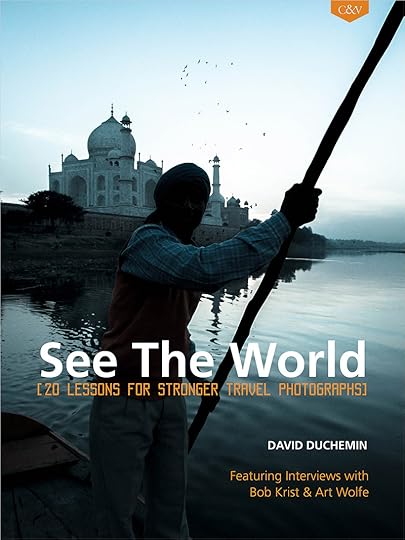
Kate: You’re back in Venice. You said it was the 5th or 6th time you’ve been here. Why Venice?
David: I think I like Venice because by nature it’s so labyrinthine. Not just as a photographer — I mean, it’s beautiful. But it’s not just the possibility of getting lost, it’s the very necessity of getting lost, and I think for me, that’s part of what I like about travel. If I wanted to stay somewhere familiar, I’d stay home. Going to a place that lacks, or at least has a different kind of homogeny than home does, but also just forces you into a discovery and exploration because it’s so unfamiliar. So, for me, it’s a place where every day I can get lost. Along the way, there’s spectacular food, and there’s great wine, it’s a very sexy city, and the light here is truly beautiful. So all of that combined with the sound of the Italian language, it just puts me into a sensory overload.
Even on the 5th, 6th visit?
Even more on the 5th or 6th visit, because the first couple of visits I was so scared of getting lost. My version of getting lost was just going from the hotel to Piazza San Marco, and I felt like I was getting lost even though I was on these well-trodden paths. Now, into five or six visits, I feel a rare freedom, because I know that getting lost isn’t truly getting lost. There’s only so many roads in Venice, you can eventually come back to your place.
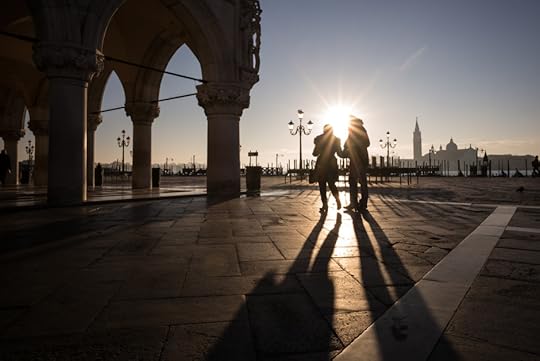
You mean because it’s an island.
Yeah, it’s, you know. There is so much possibility to get lost, and it’s like a kid in a department store, but you’re not going to get so lost that you’re not going to see mom again. And so I find here that the longer here I am, the more free I am. It’s a little like creativity. Creativity happens best within constraints. I think here, getting lost, there IS the constraint of the fact that we’re on this island. You’re not going get that lost. Within that, there’s a great freedom just to photograph and see what there is to see, knowing that at the end of the day, it’s not that hard to get to a central landmark.
So that’s why I love it. I don’t think most places in the world are that different from it. I mean, Paris is the same way. You can find your way back from the Eiffel Tower or the Champs Élysées or wherever your metro stop is. Then, within that, you have such a freedom to get lost. And that’s what I love about photography as well as just travelling is that ability to getting lost and exploring and discovering. I think getting lost is fundamentally human, but when you have a camera in your hand, it gives you an even further motivation to do that.

Kate Siobhan Mulligan captures a kiss; David DuChemin captures the moment.
Have you ever been legitimately lost?
I did have one experience in the Amazon when we were looking for something and —
You just went to the Amazon looking for something?
Well, no. We were in the Amazon to go build a school for street kids years ago.
Oh, you’re young in this story.
Very young. 18? Pre-life. This was my initiation. We were running through the jungle and we got kind of separated from the rest of our group, and there was a moment where I felt so deeply, truly lost. And when you’re in the jungle, it’s very different than if you’re in a city. The urban jungle is a metaphor, but it’s a really crappy metaphor, because the jungle has, like, you know, panthers.
In the end?
It was fun. The only part that wasn’t fun was that moment of realization of, “Oh my God, we have no idea were we are, and no one else knows where we are.” And yet, it remains one of the biggest, and in my own mind, one of the best stories because we were so lost. You know, I continue to come back to this idea of “What doesn’t kill you gives something to blog about.” It’s a good story, it’s a good adventure. And the only one that’s not a good story or a good adventure is the one from which you don’t return. You know, by then, you’re probably dead and don’t know it anyway. So go and get lost and see what there is to see.
Do people still warn you when you go on trips, like, “Oh, be safe?”
Oh, I get warned all the time! All the time. Except, I got “Be careful when you go to Haiti and Ethiopia” and all over. However, the only place I wasn’t warned about was Tuscany, which is where I had this accident in Pisa. I fell off the wall, I broke my feet, and I carry this Medjet evacuation policy, and I thought that I would probably get hauled out of the Congo with a bullet hole or something. No one ever said, “Watch out for Tuscany!” For me, it underlines that all of us, on some level, are a little risk-averse. What that risk is is different from person to person. But at the end of the day, it’s all so completely an illusion, this idea that you are safe or you are not safe. I’ve been in places that no one would call safe and yet have felt very, truly safe, and places that no one’s ever warned me about, and then I’m lying in an ambulance, being dragged to the hospital.
I had been writing on my blog, before this fall, about the illusion of safety and taking risks, and it seemed like fate making sure I wasn’t completely talking nonsense, that I really believed what I was saying. And more and more, I believe that you can never truly know, so it’s far better to experience this life, and to take risks, in general. Because you can’t avoid a risk. The only question is which risk can you live with? The people that will lovingly remind you that, “Oh, it’s so risky to go to Africa,” will not know that for me, it’s a greater risk to stay home. I’m okay going to Africa and getting into some trouble. I’m not okay living my life at home and having regrets the day I die and realize I could have done this, or I could have done that. That, to me, is the greater risk.
Did you take any risks in 2014?
Not in the way people would think. In 2014, I had another surgery on my feet — which I broke in that fall in Pisa — so I took almost the entire year off. I started 2014 in Lalibela, Ethiopia. I did one trip there. From there, I went to Kenya. I took my mom on safari for her first time and watched her mind just kind of explode. She was seven years old again. It was just amazing. And then my partner Cynthia and I went to Zanzibar and did scuba diving for a couple weeks.
But then I went home to this surgery and, you know, I guess in the bigger picture, the risk was taking time off to heal give in hopes of more mobility, and less pain. And so far it hasn’t. So far, it’s been very disappointing, and I took a whole year off to basically gain nothing. But it was a risk I chose to take.
I know you did a big road trip across Canada with your partner, Cynthia.
We did a cross-country trip across Canada on the Trans-Labrador Highway from Vancouver to Halifax and back. We drove 22,000 kilometres. We had my jeep, with a tent on top. But that trip never felt like a risk to me. That actually felt like me filling my calendar with something that I felt I knew would be okay in case my feet didn’t heal the way I expected, in case I needed to go back in for another surgery.
Any other risks from 2014?
Another risk was publishing two books that were close to my heart. You know, I made my living publishing photography books. And so, in 2014, we put out two books, but they were life books, not specifically about photography. Now, they tie in because I think photography is about life. I don’t believe life is about photography. Photography is, for me, a way for me to approach life, and so these books were another way for me, they enabled me to approach the things I deeply believe about life, and what it means to have a life well lived.
And those two books were A Beautiful Anarchy and How To Feed A Starving Artist?
That’s right.
And so, you’re of the mindset that everyone is, at heart, a creator to some extent?
Absolutely! I mean, whether you’re making a business, whether you’re making a family, whether you’re creatively solving the world’s problems through philanthropy. The arts have co-opted the word ‘creativity’, so we think about creative people only being, say, actors. The only person in the world you don’t want to be overly creative is your accountant. But I mean, even then, I say it tongue-in-cheek, because even problem solving is creativity. If we can approach life as an exercise in creativity and make even some of the more artistic endeavours more successful and apply those to daily life, I think we will live more deeply human. We will be more content and more satisfied.
Where you are right now, in Venice, sitting next to a window with quite a lovely view –
It is a lovely view, it’s not bad.
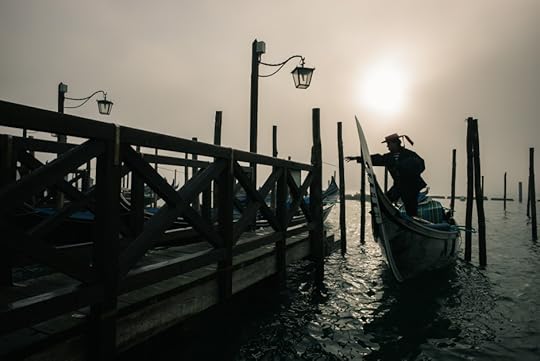
The gondoliers are cruising by at eye level, you can just stick your hand out and take funky exposures on your iPhone. Is this where you thought you’d be?
Most days, I wake up and can’t believe wherever I am. I don’t think I thought I’d make it this far. There is an incredible freedom in realizing the misconception that travel is that travel is so expensive, you know. It certainly can be, but it doesn’t have to be. You just make compromises. You know, we don’t own giant big-screen TVs, and at this point don’t own a home; I just have the jeep, in storage 250 days a year.
So we make our compromises in some areas, so we can afford to come and sit here. If you’re smart about how you spend your money, there’s no reason why you can’t spend Christmas in Venice instead of Christmas at home in Vancouver.
Absolutely. And speaking of Christmas, it’s also your birthday. Do you get reflective on your birthday, or do you just look ahead?
No, I’m profoundly introspective, and that corresponds to how much wine I’ve had.
But, no, the one thing I don’t do, I don’t look back with regret. I don’t look forward with longing so much as I am deeply grateful for my experiences. You know, a lot of people, the older they get, the less they talk about their birthdays. For me, I think it’s yet another reason to celebrate having made it this far and the possibilities and the things that we fill our years with.
But, one never knows. My birthday is Christmas Eve, January is hot on the heels of Christmas. It’s named after the Roman god Janus, who is represented as two faces in the sense that one face is looking into the past, and one face is looking into the future. But it seems to me that if one face is looking into the past, and one is looking into the future, there’s no moment at which you’re simply living in the present. So rather than be introspective in the sense of “What am I going to do?” or “regretting what I haven’t done,” I think the healthiest place to be at is to, if you’re going to look back at all, look back with gratitude. If you’re going to look forward at all, look back with hope and anticipation. But neither of those should take me out of the present and prevent me from just being here right now, right this minute.
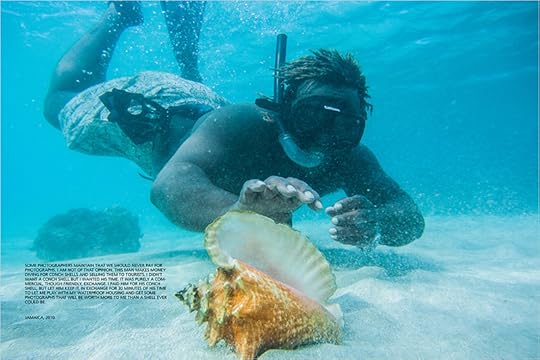
“Right here right now” is pretty damn good.
And today is all we have. Yesterday’s gone.
So, looking ahead to 2015… Oh my God, 2015. Who knew? Where’s the flying cars already?
I want my rocket pack.
You have a book coming out in February, early 2015.
I have a couple books coming out next year.
A couple! The one I’m thinking of is See The World: Twenty Lessons. I liked that title. It’s of your travel photographs. I like lessons, not tips.
Twenty lessons… I don’t know, tips are useless. Tips are like, “Hey, did you try this?” The only thing more useless than a tip is a rule. You know, Twenty RULES For Great Travel Photography. I look at something like that, and it tells me what not to do. There’s a note in our kitchen that says, “Private: Don’t open this door.”
So lessons, then. Are these lessons that you’ve learned over the years?
Yeah, I think the only way you can teach is to be constantly learning. And I am, by nature, very introspective. The things I teach are not rules. They’re the things that I have learned. I like the word ‘principle’. I don’t like the word ‘rule’. Because a rule implies that if you break it, there’s some kind of consequence. This is art, for God’s sakes. There’s no consequence other than someone might say they hate your photograph. Is that the worst of it? Well they might say that and follow the so-called rules too.
I think I wrote this book as a reaction to a lot of things. I don’t know if it makes a difference in the way that I travel and make photographs. Because I don’t actually believe — and this is the funny thing about this book — it’s a book about travel photography, but I don’t know there’s such a thing as travel photography. Say you live in Paris, you go to a restaurant, take pictures of your food, is it travel photography? No, it’s food photography. It’s the same if you make portraits of someone on the street. Is it street photography, is it people photography? Well it is if you live there. But if you’ve travelled to get there, now it’s travel photography. So ultimately, there are no “tips” for making better “travel” photographs. Because what makes a great travel photograph where you are when you travel is the same thing that makes a great photograph when you’re at home.
So my “tips” for travel photography become lessons for stronger photographs, but they’re “travel” in the sense that they revolve more around experiencing a place. And then, how do you take the experience, or more generally speaking, your intention when you are doing so-called travel photography, is to imbue these two-dimensional photographs with that amazing experience that you’re having of a place that’s not your own. That’s what the book is about. And yes, I have a couple sidebars about a “hack”, about carry-on, how to get your camera on a plane without getting it lost, what kind of bags do you use, and tripods… But those are not among the twenty lessons. The twenty lessons are the important stuff. How you experience a place, how you see a place, what is my creative process when I’m in a new place, like Venice.
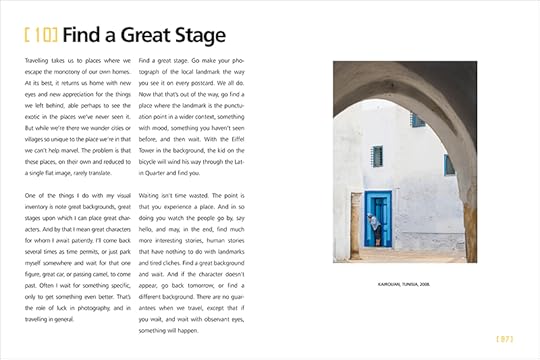
Getting lost, again.
Yeah, and every time I get lost again it’s in different weather, in different light, with different things going on, so it is kind of a new place and a new opportunity for photographs. So I think that’s the spirit of the book. And I’m not doing it to be iconoclastic, I just think it’s a better way of teaching.
It’s not, “here’s a checklist, do these ten things, and have a great travel photograph”. It’s an approach. It’s like a paradigm shift.
I think it’s a paradigm. I really do. Again, it’s not iconoclastic, it’s not twenty rules to break. It’s not, “Here’s how to be the black sheep of travel photography.” My stuff, you know, it’s not totally bizarre stuff. But it answers the question: “How do you make stronger travel photography? How do you imbue these images with an experience that is multi-sensory, that is so full of emotion, and discovery, and how do you make your photographs come a little closer to aligning with that?”
Especially without sacrificing the process of discovery and exploration and travel that you would have if you didn’t have a camera. Because I think sometimes our cameras get in the way. I think sometimes we’re so hell-bent on making great travel photographs that we don’t even experience the place.
I like that. A place is not a creature to hunt down with the one perfect photo.
But we make it so.
We’re predators.
We are! And I think that if you can instead come to a place and have a daily routine where you go get your cappuccino, you go to art galleries, you take some time to do your other work. You can take that time just to be a normal human being and not one of these cyborgs with all this technology swinging from your shoulders.
Frantically power walking from viewpoint to viewpoint…
And hunting for that trophy, you know?
To get the same photo that everyone else already got.
Exactly. And this is the problem with so-called travel photography. You get off the plane, and the first thing you want to do is you want to shoot the photograph that you’ve seen someone else take instead of getting off the beaten path. It’s hard! It’s not easy for anyone.
There’s a quote in there: “This is not a book about being a tourist with a camera.” Which I really enjoyed. So then who’s the book for?
It’s for people who are really willing to be travellers.
Which is not a tourist.
Well, it’s semantics, but I think a tourist goes to see something very specific. I think a traveller goes without a checklist to see what is there and be surprised by what they see — to embrace other cultures, rather than to come all this way and go to the friggin Hard Rock. I mean, every time I pass the Hard Rock in Venice, I think, “Do we really need this?”
But they will not veer from their preconceived notion of –
They’re terrified of getting off the beaten path. And we all experience that. I’m not saying that I don’t experience fear. The difference between the tourist and the traveller is the tourist gets nervous about that. Experiences the fear. It pushes them back onto the beaten path. The traveller, if we’re going to make this distinction, says: “I’m fearful of veering off, and that’s exactly the thing I need to do. I need to listen to my fear and allow it push me to new places and explore something that may not be in the Lonely Planet.”
God help you if it’s not in the Lonely Planet!
And I have a bookshelf full of Lonely Planets, but I stopped bringing them on trips! Because, especially as photographers, expectations get so much in your way. And the more Google Maps you look at, the more Google Image searches you do, and the more Lonely Planet books you read, as a photographer, the more those expectations tend to blind you because then you’re looking for what you’ve been told is there and should be there. You’re not looking for or seeing what actually is there. I mean, one is about discovery, and one is about ticking off something. If that’s all you want, you should stay at home, save the money and just look at pictures online.
A few of, actually I think none of the lessons necessarily are technical. It’s not about settings.
No! I mean. I spent this morning photographing with my iPhone. There are no settings on my iPhone. I have a couple apps that allow me to do some stuff. Some multiple exposures, some slow shutters, but still, at the end of the day, you’re just pressing a button. And yet, I’m making photographs that I love, that I will print, that I will probably sell, I know that I’ll put them in books. So no, I have no interest in telling people what f-stop to use.
“This is the one!”
It’s funny — we were in Oaxaca, Mexico for the Day of the Dead, and we were sitting with a group of photographers who were down there to teach, and there was another group sitting just across from us and they all, at the end of the meal, picked up their cameras and walked out. And the one woman said to the other as they walked out, “Now remember! Your F should be 5!”
And all of us looked at each other, like, “Your F should be 5? I don’t even know that I have an F-5, per se! I think I have an F/5.6, but your F should be 5!” So that’s become my mantra. It was actually going to be a much shorter book. If you want to make photographs, your F should be 5.
You need a t-shirt that says “Your F should be 5”. Now, the book includes some interviews with pretty cool people.
It does. At this point it’s got an interview with Art Wolfe, who’s a one-time hero of mine.
Why?
Well, Art’s been doing this for 40 years, he’s travelled the world, he’s seen some amazing things, but he also approaches his travel photography less as a documentarian or a reporter, and more as an artist. Not in a pretentious sense. But he’s quite willing to orchestrate his photographs to create the greatest sense of place that he can.
Whereas someone like Bob Krist, who also has had a very long career in travel photography, he’s been a National Geographic photographer, he’s a wonderful man; I love Bob. In fact, the last time I saw Bob was probably that same day we went to that restaurant and was told our F should be 5. He was on a separate trip in Oaxaca, Mexico. He’s a lovely guy and I like him. He certainly has an artist’s eye. His stuff has a greater sense of spontaneity to it. And then I’m hoping that by the time we publish the book that we can also get Nevada Wier. She’s promised to get me something, but the problem working with travel photographers is they’re always somewhere else, so she was in India for a while, now she’s in Cuba. So will I actually get an interview with Nevada, I’m not sure. Hopefully those three. And I love Nevada’s work as well. She’s a beautiful photographer, she’s a wonderful human being. So I think the three voices together, if I can get all three, they’re a complement to the places.

Whereas someone like me, who says, “Travel light, take as little gear as possible,” you know, Art Wolfe says, “Well, actually I’m quite happy with my gigantic Canon cameras and a bunch of big lenses.” Because they allow me to do the job. He’s comfortable with bigger gear. And I am embracing the mirrorless stuff much more quickly. It may be a function of being a little younger, being more adaptable. Or we just like the tools we like. You know, I like my Fujis and my Leica, and Art likes his Canon 1D X.
And there was a big chapter in here, in the sense of going lighter, and so what have you brought to Venice? I see a pile of cameras.
There is a pile of cameras. Only two of them are mine. I brought a Leica digital M and a film, and an M6, and a bag of black-and-white film. And I brought my little 18-mm Moment lens for my iPhone. And it just clicks on and I’m as happy with my Leica as I am with my iPhone.
I don’t know if Leica wants to hear that.
Well, probably not. But Leica’s got… you know, they’ve got their own thing going on. Ultimately, for me, it’s a photograph. I love the feel of my Leicas. They’re beautiful tools. They feel right to me. They get out of the way very quickly. But so do my Fujis. I just didn’t bring my Fujis. You can only carry so much. But for me, yes. I talk in the book about going lighter because I think as human beings, the lighter we travel, both materially, emotionally, the better we…
Get out of our own way.
Yeah, the more we get out of our own way. The less crap we have. I’ve travelled with so much gear, I’ve spent more time figuring out what lens I want to put on the camera than I do making photographs. Whereas, even on my Leica, I brought four lenses, all of them are primes, and I will probably shoot with my 21mm, and my 35mm 99% of the time, and I probably won’t even leave the house with my 50 and my 90. Because they’re not the focal lengths I like. But I like the constraints! I like having the 21mm lens for the morning and going, “Well, that’s what I have.”
You leave with it and work with what you have.
Yeah, and you don’t have to go, “Oh, which lens should I use?” Well, I guess I got one, so you use the one you have. And artists since the dawn of time have worked with what they have. More options don’t always net the best results.
No. A lot of people clamour that a new piece of technology is going to solve the problem of why they’re not happy with their pictures.
And let’s face it, high ISOs — they’ve opened up all kinds of new possibilities, you know, you can shoot in light that you might not otherwise have shot in. But the camera has changed very little since it was invented. It’s a box with a hole in it with a lens on the front, and some vector to make the image — a film or sensor. It’s not that complicated. The key to photography is recognizing lines, light, moments, and being able to go for it. Knowing your craft enough that you can create the art out of what life, the universe, gives you in these moments.
Which is kind of what the book’s about, in the long run.
In the end, it is, because I think the central premise of the book is you cannot photograph what you have not experienced. So anything that gets in the way of your experience prevents you from making better photographs. If that means carrying 50 pounds of gear around Venice and trying to choose between a 500mm lens and an 8mm fisheye and everything in between, you might spend more time paralyzed by your decision-making process than you will perceiving what’s going on. You won’t see all the changes in light or the moments that present themselves to you. And whether you have a camera or not, as a traveller, the point is to experience the place. And a Lonely Planet book can be the same thing. You spend so much time with your nose in a book that you’re missing what’s going on around you and the magic.
To an extent, it’s about vision. Vision being a keyword in your journey. From Within the Frame — a book which has a profound impact on my own life and journey — to your latest books, what’s made you so passionate for the aspect of it all? The vision, as opposed to technical visions. Because there’s those photography books as well.
There are. And without sounding pretentious, all those other books are garbage. That may be overstating the case. But the fact is, it all begins and ends with vision.
That’s been almost your mantra for a decade.
Sure, and my vision’s changed as a human being, and I think everyone’s does, but if you’re not photographing from that vision, from what you see, feel, experience, believe, sort of this — vision is kind of this hairball that encompasses a lot of things.
Visually, the missing thing for a lot of photographers. They have the gear, they have the settings.
It’s not hard. Anyone can learn to, I don’t know, I mean —
The F is 5!
Your F should be 5! Really though, the most iconic photographs are so rare. But without a sense of vision, without understanding lines and moments, how do you start this? Vision is what makes it art. Now, that’s a bigger argument: is photography art? I think it is. But it certainly can remain only craft. Anyone can take a technically perfect photograph, but is it art? I think what separates the technically perfect photograph from one that is evocative and that changes the way people think and see and that expresses the way a photographer feels about a certain thing, the thing that stands between the two is vision and the ability to explore it and express it in new and authentic ways. Changing ways, but new and authentic ways that are genuine to ourselves.
To wrap it up, and so we can return to drinking and looking out your lovely window onto the canals — it’s your birthday, it’s the end of the year, it’s the cusp of 2015. Matador has a photography program. We have students finishing up the course and they’re kind of on that cusp. That kind of point, like “jump or don’t.” They think signing up for the course was kind of a jump in itself. So then they finish it and it’s like “What’s next?” What advice would you give – God, how many times have you been asked that? – to someone on the cusp to make 2015 count in the realm of travel photography?
Well, figure out what you want, truly; and dream big. The fact is, we’re all writing a story. We’re all writing our own story, and you can either live a great story or you can read someone else’s great story. The best travel photography comes out of great travel. Go somewhere. Get off your ass and go. Forget the money. You know, I’ve shot beautiful photographs with the kit lens that came with my Fuji XE1. And I have images in my books from my iPhone!
You took some this morning even. I watched.
It probably will be in See The World. There will be some from this morning, and the rest of the trip. The gear is so irrelevant that’s it’s almost not worth talking about anymore. Henri Cartier-Bresson had one Leica and a 50-mm lens, probably a 35-mm lens for some of his stuff, and he made amazing stuff. They were beautiful, but they didn’t perform any better than even the most basic cameras we have. I mean, the optics were good, but people don’t look at Henri Cartier-Bresson’s stuff and go “My God, the lens that he used was amazing.” They look at it and appreciate it for his sense of timing, his understanding of moments, and because he was there and he saw. And to get back to your question, the best thing anyone can do is go see the world, experience it, be part of it, whether it’s your backyard in Vancouver or Toronto, New York or San Francisco, whatever, just see it. Be a part of it. Live.
Participate.
And bring your camera with you. That’s the best advice any photographer can get, is go be there and, of course, be good at your craft.
I did teach you last night how to use a camera on your iPhone.
You did. I don’t remember how.
Well, on that note, let’s drink.
Let’s. 
This Welsh town is a contest capital
LLANWRTYD WELLS, UK — There is an annual race between people and horses in this tiny Welsh town, and yes, a horse almost always wins.
But that’s not really the point. Whether it’s the Man vs Horse Marathon, the World Bog Snorkeling Championships, the Stone Skimming Championships or any of the contests hosted here each year, the same winner comes out on top: Llanwrtyd Wells.
Once a popular destination for Victorians seeking pony treks and restorative spas, the hamlet has weathered changing holiday tastes by rebranding itself as Britain’s capital of wacky challenges.
With a little bit of hustle, a lot of showmanship, and a population just greater than a full Airbus A-380, Llanwyrtd Wells has saved itself from the economic torpor that’s consumed many Welsh and English towns whose industries have disappeared.
“Without the events, this place would be one huge white elephant,” said bartender Lindsay Ketteringham from behind the taps at the Neuadd Arms Hotel.
It was here in the scuffed 21-room hotel in the town center that the new Llanwrtyd Wells was born.
It was 1980. The natural spring spas that drew people by the thousands in the 19th century had long closed. The pony treks to the surrounding Brecon Beacons mountain range that attracted later visitors were falling out of fashion as well.

Huw Lobb (L), the first man to have beaten a horse, with event founder Gordon Green. (Corinne Purtill/GlobalPost)
Then owner of the Neuadd Arms, Gordon Green saw a problem. And then one night, after overhearing two customers in the hotel bar argue over whether a particular distance was the same to a man and a horse, he came up with a solution.
A footrace between people and horses. People would come to see that, right?
“We just wanted to fill the bed spaces,” Green says.
The first Man vs. Horse Marathon took place that year. It was a success. A few years later, Green organized the World Bog Snorkeling Championships in the nearby Waen Rhydd bog.
More events followed in the vein of things-that-are-at-once-great-and-terrible ideas, like the Real Ale Wobble, a mountain bike ride during which participants chug beer instead of water at rest stops.
It culminated in Llanwrtyd Wells landing the World Alternative Games, an annual two-week festival in August of nonsense contests such as sack fighting, bog dredging, finger jousting and competitive rock, paper, scissors.
The town’s cheerful self-promotion is relentless. Nearly every resident repeats the claim that theirs is the smallest town in Britain. A check of official figures reveals several other hamlets that could claim the title, but none that market it as insistently as Llanwrtyd Wells.
“It’s eccentric Brits at play. It’s people who come along and have a good laugh,” says Peter Jones, a spokesman for the World Alternative Games. “Gordon’s been the driving force behind it all.”
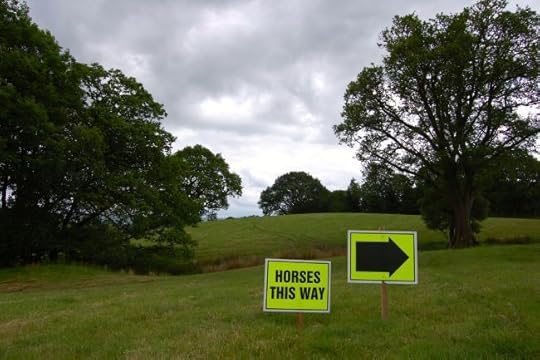
(Corinne Purtill/GlobalPost)
At 79, Green still has a mischievous twinkle in his eye. On Saturday, he made his way through the crowds at the 34th annual Man vs. Horse Marathon like the local celebrity he is.
The only other person to draw as many cheers was Huw Lobb, 37, a former Cambridge University cross-country runner who in 2004 became the first man to beat the horse, a feat accomplished only once more since.
Llanwrtyd Wells is nestled in the heart of Wales’s sheep-farming country. Tractors number among the few vehicles passing through the town center. Stone bridges and wrought-iron balconies recall the long-gone heyday of its years as a Victorian holiday destination.
Some locals still remember what it was like in the days before bog snorkeling and boozy bike rides put it back on the map.
“It was quiet,” says William Idris Jones, 86, a “semi-retired” sheep farmer and native Welsh speaker who’s lived in Llanwrtyd Wells since he was 12. “It wasn’t dying, but it’s improved a lot. [The events] made a big difference.”
With more than 430 runners and 56 horses, last year’s Man vs. Horse was the biggest yet. Its main sponsor, Whole Earth Peanut Butter, handed out peanut butter balls and cookies to runners stretching in front of the Neuadd Arms.
The horse course is 24.8 miles, the human one 23.6. Horses must stop halfway through for a vet check to make sure they’re not overheated.
Winner Leo and rider Geoffrey Allen crossed the finish line at 2 hours and 23 seconds, besting the closest human competitor, Jonathan Albon, by 20 seconds.
No one seems to mind that the horse usually wins.
“If they’ve got a Shetland pony running, maybe. Otherwise I’ve got no chance,” said John Cooney, 35, before running off into the hills. 
By: Corinne Purtill, GlobalPost
This article is syndicated from GlobalPost.
Mini-guide to German slang

Photo: Amit Gupta
1. A German doesn’t “cut school or work…he “makes blue” (Blau machen).
2. A German doesn’t “beat someone up”…he “mixes someone up” (Jemanden aufmischen).
3. A German doesn’t “make fun of you”…he “pulls you through the cacao” (Jemanden durch den Kakao ziehen).

More like this 9 American habits I lost when I moved to Germany
4. It’s not “all Greek to a German”…he “only understands train station” (Nur Bahnhof verstehen).
5. A German doesn’t “turn you down” if you ask for a date…he will “give you a basket” (Einen Korb geben).
6. A German doesn’t have “a skeleton in his closet”…he has “dirt on the stick” (Dreck am Stecken haben).
7. A German woman does not have a “nice rack”…she has “a lot of wood in front of her shack” (Ordentlich Holz vor der Hütte haben).
8. A German is not just “slow on the uptake”…he has “a plank in front of his head” (Ein Brett vorm Kopf haben).
9. A German doesn’t “bite the dust”…he “bites the grass” (Ins Gras beißen).

More like this 26 signs you were born and raised in Germany
10. Alternatively, he “hands in the spoon” (Den Löffel abgeben).
11. A German doesn’t “get on your nerves”…he “gets on your cookie” (Auf den Keks gehen).
12. A German doesn’t “commit a blunder”…he “steps in a bowl of grease” (Ins Fettnäpfchen treten).
13. A German doesn’t have a “sharp tongue”…he “has hair on his teeth” (Haare auf den Zähnen haben).
14. A German husband is not “henpecked”…he is a “slipper hero” (Pantoffelheld).
15. A German doesn’t “overcome his weaker self”…he overcomes his “inner pig-dog” (Den inneren Schweinehund überwinden).
16. A German doesn’t make “a mountain out of a mole hill”…he makes a “mosquito out of an elephant” (Aus einer Mücke einen Elefanten machen).
17. A German doesn’t have to “chose between the devil and the deep blue sea“… he has to “chose between pestilence and cholera” (Die Wahl zwischen Pest und Cholera haben).
18. A German is not told to “go jump in a lake“…he is told to “go where the pepper grows” (Geh doch dahin, wo der Pfeffer wächst).
19. A German is not “friggin’ blind”…he has “tomatoes on his eyes” (Tomaten auf den Augen haben). 
February 20, 2015
Selfie + drone = dronie
Follow Matador on Vimeo
Follow Matador on YouTube
COMBINE TWO of the best aspects of photography and video-making of the past year and you get a “dronie”, a mix of “selfie” and “drone”.
Alex Chacón traveled to Veracruz to experiment on this new concept and created an epic road-trip video entirely shot with a drone. Give it a watch and explore Veracruz like you’ve never before! 
Connecting with strangers
FALLING IN LOVE may feel like a magical and unpredictable event, but there’s a way to create the sparkle of love between two individuals and it explains a lot about our relationships.
Dr. Arthur Aron, the founder of that method calls it “a procedure for interpersonal closeness”. No, it does not sound romantic, but yes, it seems to work.
The process used in Dr. Aron’s study to make two people fall in love consists of a series of 36 questions that two strangers must ask each other, followed by four minutes of the same strangers gazing into each other’s eyes. This is what New York Times’ Mandy Len Cartron calls “accelerated intimacy”.
The video above only partially uses Dr. Aron’s study; the people involed are not all strangers, and they haven’t used the list of 36 questions. However, if you watch it until the very end, you notice that the four minutes during which the participants look at each other in the eyes seem to create a strong connection. Mandy Len Cartron explains this connection by the fact that the process “generate[s] trust and intimacy, the feelings love needs to thrive”.
Give it a try today with a stranger, your date, or your life partner and let us know the emotions that came out of this experiment. We sure hope it leads to a connection as strong as the ones featured in this video. 
A journey through Sri Lanka [vid]
Follow Matador on Vimeo
Follow Matador on YouTube
Photography & editing | Piotr Wancerz | facebook.com/timelapsemediapl
Music | Tony Anderson “The Prophecy” | tonyandersonmusic.com
Locations: Anuradhapura, Colombo, Dambulla, Ella, Haputale, Kandy, Negombo, Sigiriya, Tangalle, Udawalawe 
Matador Network's Blog
- Matador Network's profile
- 6 followers



